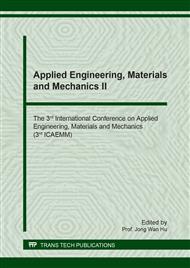[1]
R. Scaffaro, L. Botta, A. Maio, G. Gallo, PLA graphene nanoplatelets nanocomposites: physical properties and release kinetics of an antimicrobial agent, Compos. B. Eng. 109 (2017) 138-146.
DOI: 10.1016/j.compositesb.2016.10.058
Google Scholar
[2]
D. Wu, Y Cheng, S. Feng, Z. Yao, M. Zhang, Crystallization behavior of polylactide/ graphene composites, Ind. Eng. Chem. Res. 52(20) (2013) 6731-6739.
DOI: 10.1021/ie4004199
Google Scholar
[3]
Y. Fu, L. Liu, J. Zhang, W. C. Hiscox, Functionalized graphenes with polymer toughener as novel interface modifier for property-tailored polylactic acid/graphene nanocomposites, Polym. 55(24) (2014) 6381-6389.
DOI: 10.1016/j.polymer.2014.10.014
Google Scholar
[4]
A. M. Pinto, C. Gonçalves, I. C. Gonçalves, F. D. Magalhães, Effect of biodegradation on thermo-mechanical properties and biocompatibility of poly(lactic acid)/graphene nanoplatelets composites, Eur. Polym. J. 85 (2016) 431-444.
DOI: 10.1016/j.eurpolymj.2016.10.046
Google Scholar
[5]
X. Zhao, Q. Zhang and D. Chen, Enhanced mechanical properties of graphene-based poly(vinyl alcohol) composites, Macromolecules. 43(5) (2010) 2357-2363.
DOI: 10.1021/ma902862u
Google Scholar
[6]
C. Bao, L. Song, W. Xing. B. Yuan, C. A. Wilkie, J. Huang, Y. Guo, Y. Hu, Preparation of graphene by pressurized oxidation and multiplex reduction and its polymer nanocomposites by masterbatch-base melt blending, J. Mater. Chem. 22(13) (2012).
DOI: 10.1039/c2jm16203b
Google Scholar
[7]
W. S. Hummers, Jr., R. E. Offeman, Preparation of graphitic oxide, J. Am. Chem. Soc. 80(6) (1958) 1339.
DOI: 10.1021/ja01539a017
Google Scholar
[8]
J. Zhang, H. Yang, G. Shen, P. Cheng, J. Zhang, S. Guo, Reduction of graphene oxide viaL-ascorbic acid, Chem. Commun. 46(7) (2010) 1112-1114.
DOI: 10.1039/b917705a
Google Scholar
[9]
E. Y. Choi, T. H. Han, J. Hong, J. E. Kim, S. H. Lee, H. W. Kim, S. O. Kim, Noncovalent functionalization of graphene with end-functional polymers, J. Mater. Chem. 20(10) (2010) 1907-(1912).
DOI: 10.1039/b919074k
Google Scholar
[10]
P. Song, Z. Cao, Y. Cai, L. Zhao, Z. Fang, S. Fu, Fabrication of exfoliated graphene-based polypropylene nanocomposites with enhanced mechanical and thermal properties, Polym. 52(18) (2011) 4001-4010.
DOI: 10.1016/j.polymer.2011.06.045
Google Scholar
[11]
S. Mo, L. Peng, C. Yuan, C. Zhao, W. Tang, C. Ma, J. Shen, W. Yang, Y. Yu, Y. Min, A. J. Epstein, Enhanced properties of poly(vinyl alcohol) composite films with functionalized graphene, RSC Adv. 5(118) (2015) 97738-97745.
DOI: 10.1039/c5ra15984a
Google Scholar


